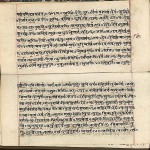Hindu scriptures are classified into two categories. The first category is Sruti which means “that which is heard”. The second is Smriti which means “that which is remembered”. Hinduism’s primary scriptures, collectively known as the Vedas, fall into the Sruti category as they are of no known origin. Indeed, they have originated from the Supreme Consciousness itself and were discovered by ancient Rishis (seers) through meditative processes. The knowledge of the Vedas was passed down from generation to generation in an oral tradition until it was penned down by Shri Veda Vyasa. Smriti scriptures could be attributed to a definite author and will be discussed in subsequent articles.
The word “Veda” comes from the root “vid” which means “to know”. There are four Vedas: the Rig Veda, the Yajur Veda, the Sam Veda and the Atharva Veda. Each Veda could be sub-categorised according to its content. There are four main sections: Samhitas, Brahmanas, Aranyakas and Upanishads. The Samhitas (or mantras) contain mantras for use during worship and in the performance of rituals. The Brahmanas contain information on the correct performance of specific rituals of value to the ritual performers (Brahmins). The Aranyakas contain philosophical and metaphysical interpretations of the mantras and rituals. The Upanishads represent the essence of the Vedas and contains discussions on the deepest philosophical questions pertaining to the purpose of life, the origin of the universe, time, space and consciousness.
The content of the Vedas could also be classified into Karma-Kanda, Upasana-Kanda and Gyaan-Kand. The Karma-Kanda sections deal with rituals and sacrifices (Samhitas and Brahmanas). The Upasana-Kanda deals with worship and meditation (Aranyankas). The Gyaan-Kand deals with the highest knowledge or wisdom (Upanishads). A brief description of each of the four Vedas is as follows:
Rig Veda: Derived from the root “rik” meaning “to praise”, the Rig Veda contains a collection of mantras in praise of deities such as Indra, Agni and Soorya. The mantras also address the supreme in various devotee-God relationships such as friend-friend, parent-child and servant-master.
Yajur Veda: Derived from the root “yaj” meaning “to worship”, the Yajur Veda contains a compilation of mantras used in performing Vedic rituals and sacrifices. It also contains the procedures for the performance of different yagyas.
Sam Veda: “Saama” means to bring shanti or peace of mind. The verses of the Sam Veda were chanted with the use of music, giving rise to the seven notes or swaras used in Indian Classical musical artforms.
Atharva Veda: The Atharva Veda contains verses with solutions to problems faced in daily life. Areas such as agriculture, health, relationships and warfare were all addressed. The system of Ayurveda (science of life) has its roots in the Atharva Veda.
The Vedas are considered the source of all Hindu scriptures as all other scriptures expand on the essential principles embodied within the Rig, Yajur, Sam and Atharva Veda. The contents of the Upanishads will be examined in next month’s article.



